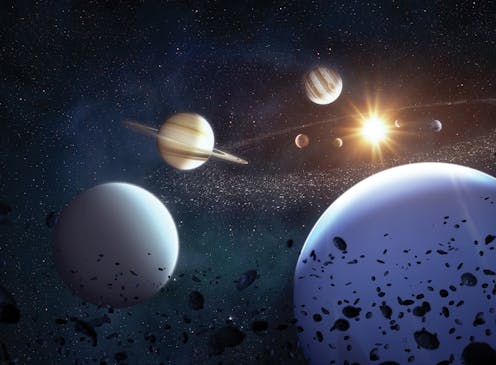
Curious Kids is a series for children in which we ask experts to answer questions from kids.
How are planets created? - (Saba, 6, Kenya)
Thanks for asking such an interesting question, Saba. When you talk about planets you’re probably thinking of the planets in our solar system – the ones orbiting (circling around) our sun. There are eight of these planets. One of them is where you and I live: Earth. The others are Mercury, Venus, Mars, Jupiter, Saturn, Uranus and Neptune.
There are many, many more planets way beyond our solar system and our galaxy, the Milky Way. Scientists like us, known as astronomers, have found over 5,000 planets around other stars. We estimate that there may be trillions across the Universe.
How did they come into being? It all starts with a cloud of gas and dust.
Gas and dust
These clouds of gas and dust are called nebulae. They float around in space much like the clouds in our sky. There are some regions with more clouds and some with fewer and astronomers can see these using telescopes.
Nebulae contain gases like hydrogen, helium and carbon. When a nebula becomes dense enough its gravity pulls it together into a very dense core. This is a bit like the water in your bath swirling around the drain before getting sucked down. As the cloud gets dense it heats up. When it gets dense and hot enough the atoms – tiny building blocks for all the matter in the world – in the nebula start to fuse.
This process is called nuclear fusion and produces a lot of energy. And the cloud lights up like a firework. This is how a new star is born, just like our Sun was 4.5 billion years ago.
A small amount of gas and dust remains around new stars in a spinning disc. Planets are formed from this disc of material.
Protoplanets
As the disc rotates, the material in it, small bits of rock and ice, lump together and get bigger and bigger. That forms what we call planetesimals, which collide with each other like bumper cars, creating even larger bodies known as protoplanets.
The protoplanets keep growing. While this is happening, they can attract gases from the surrounding disc, creating a thick atmosphere. This process is called accretion and it is how gas giant planets like Jupiter and Saturn are formed. If a protoplanet forms from heavier elements in the outer solar system it can create an ice giant. The planets Neptune and Uranus are ice giants.
Even after the planet is formed it can keep changing over time through processes such as volcanic activity, tectonic movement, and erosion. On Earth, mountains like Mount Kilimanjaro in Tanzania – the country next door to Kenya – formed from large volcanoes. And even larger mountains like the Himalayas have formed from tectonic plates colliding. Tectonic plates are big pieces of the Earth’s outer layer; sometimes they crash into each other and that creates things like mountains.
Millions of years
The way I’ve described this makes it sound as though planets are formed quickly. But the process which begins with those clouds of gas and dust takes millions of years to transform into the beautiful and diverse worlds we see in our Solar System and beyond.
Daniel Cunnama receives funding from the National Research Foundation and the South African Astronomical Observatory.
This article was originally published on The Conversation. Read the original article.







